The Ultimate Shrimp Guide
Everything You Need To Know To Keep Shrimp With Confidence

Learn In 3 Simple Steps

Step 1: Crash Course
Enter the road to being a confident fishkeeper with all the facts you need to know about fishkeeping.

Step 2: Tank Zero to Hero
All The tools you absolutely need and none of the ones you don't.

Step 3: Easy Care Hacks
How to care for shrimp in less than 30 minutes a week, written for the busy people living in 2024.
What Are Pet Shrimp Anyway?
The idea of keeping seafood as a pet may sound crazy at first, but dwarf shrimp are a very popular pet now adays in small and large aquariums.
- They are different from the shrimp you eat in a couple of ways:
- They’re smaller, growing between 0.5 to 2 inches in length.
- They require freshwater instead of saltwater.
- They come in a variety of vibrant colors that bring a lot of joy to your aquarium.
Popular Types Of Shrimp
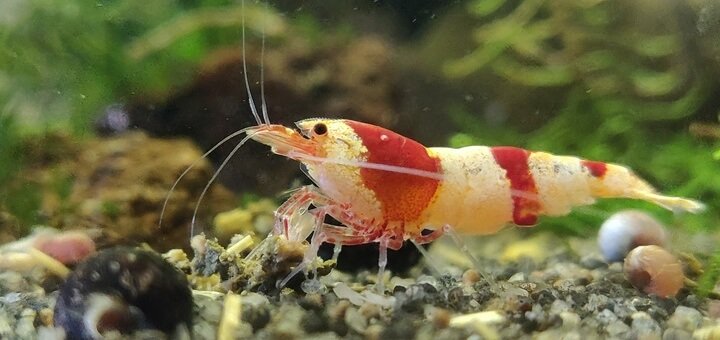
Crystal Red Shrimp
Crystal red shrimp are appreciated for their striking red and white coloration. There are various grades and patterns, and they require specific water parameters for optimal health.

Cherry Shrimp
Cherry shrimp are known for their bright red coloration, and they are one of the most popular and widely kept shrimp in the aquarium hobby. They are relatively hardy and suitable for beginners.
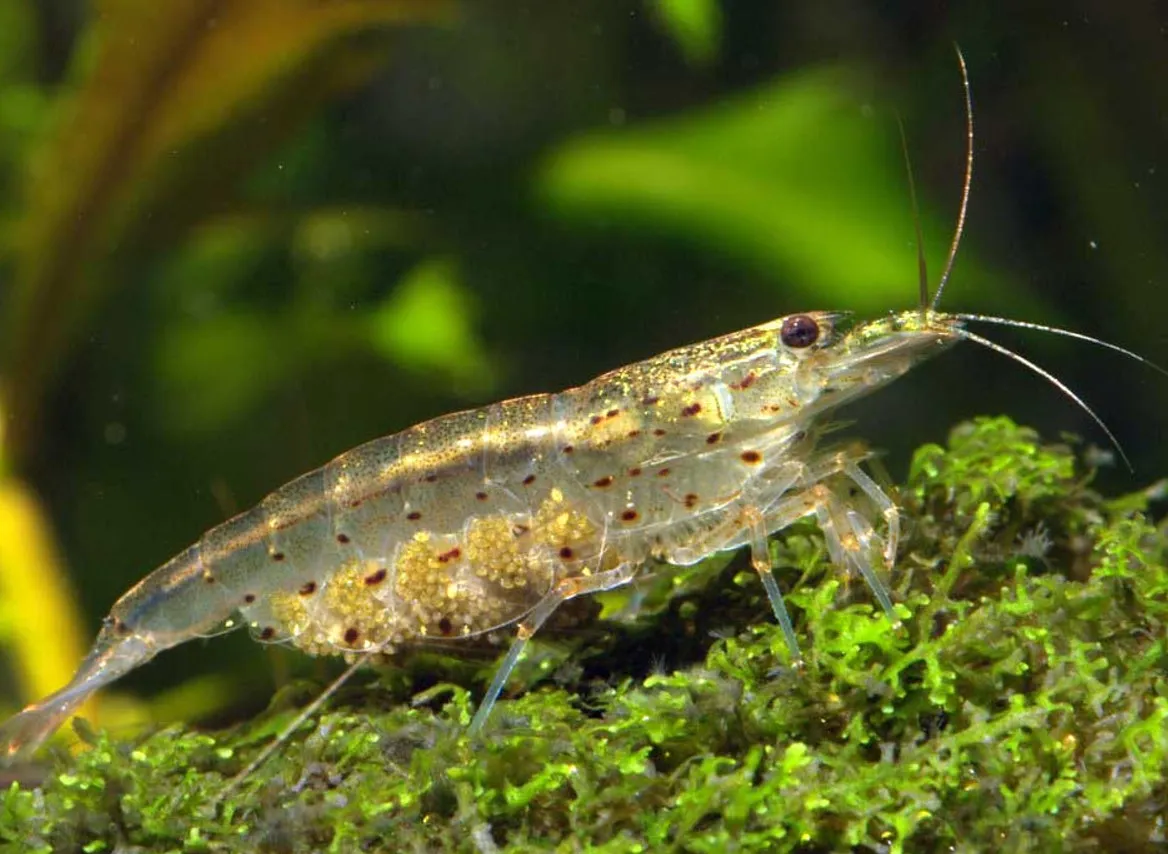
Amano Shrimp
Amano shrimp are valued for their algae-eating abilities and transparent appearance with distinctive long rostrums. They are often used as natural algae control in aquariums.
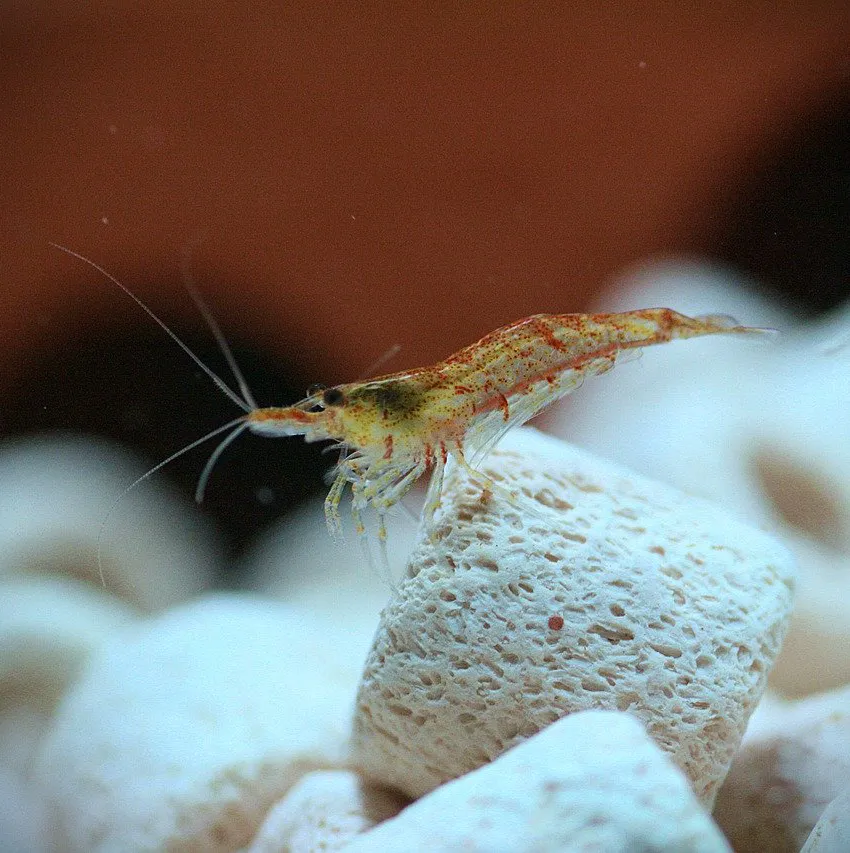
Bee Shrimp
Bee shrimp, including Black Bee and Red Bee, are selectively bred Caridina shrimp known for their unique color patterns and markings. They require specific water parameters similar to Crystal Red Shrimp.

Blue Velvet Shrimp
Blue Velvet Shrimp are a color variant of Neocaridina shrimp, featuring a solid blue color. They are relatively easy to care for and add a pop of color to aquariums.

Ghost Shrimp
Ghost shrimp are transparent and often used as feeder shrimp in the aquarium trade. They are hardy and relatively easy to care for, making them suitable for beginners.
What's Required Of You
In A Nutshell
Feed: Twice A Day | 10 Minutes
Clean: Once A Week | 30 Minutes
Feed Your Shrimp Twice A Day
Feed your shrimp twice a day with commercial fish food. For treats, use live food like brine shrimp (it's different- more on that in a second) or vegetables like cucumbers or zucchini.
Replace 25% Of The Water Weekly
Do a 25% water change about once a week. While changing, siphon the bottom of the tank and scrape algae if needed.
Shrimp as Tank Mates
The #1 reason shrimp are so popular is because they make great tank mates. They occupy the lower level of the tank and feed off the food that fish didn’t eat. What that means is they get rid of the food that would otherwise rot and force you to do a water change.
In other words, dwarf shrimp allow you to go longer between water changes in an organic way.
Some of the most popular matches for them are:
- Guppies
- Endler’s Livebearers
- Rasboras
- Danios
- Tetras
- Corydoras Catfish
- Otocinclus Catfish
Commitment level
A daily routine of 10 minutes is required when feeding your shrimp. On top of that, you’ll need to spend an additional 30 minutes a week during water changes.
What about vacations?
the secret to keeping your shrimp alive while going on vacation is doing a water change right before you leave. They can go about 10-14 days with food and survive.
Moving a shrimp tank
Moving a small fish tank is pretty simple. The only restriction is moving by flight, which will make the move pretty hellish. That applies to all fish, and not just shrimp in particular.
Feeding Your Shrimp
Shrimp are super simple to feed. If you plan on keeping them with other fish, you’d feed them the exact same way as you feed your fish. When it comes to food choices, most beginners go for commercial fish food because:
- It’s shelf-stable and doesn’t require refrigeration.
- It’s scoop and serve- no prep needed.
- It meets the dietary needs of your guppies.
- It doesn’t make a mess.
There are plenty of brands out there like Hikari or Tetra, but as long as you get food marketed as “tropical fish food” you’ll be ok.
Here are the 3 top options for food that beginners like:
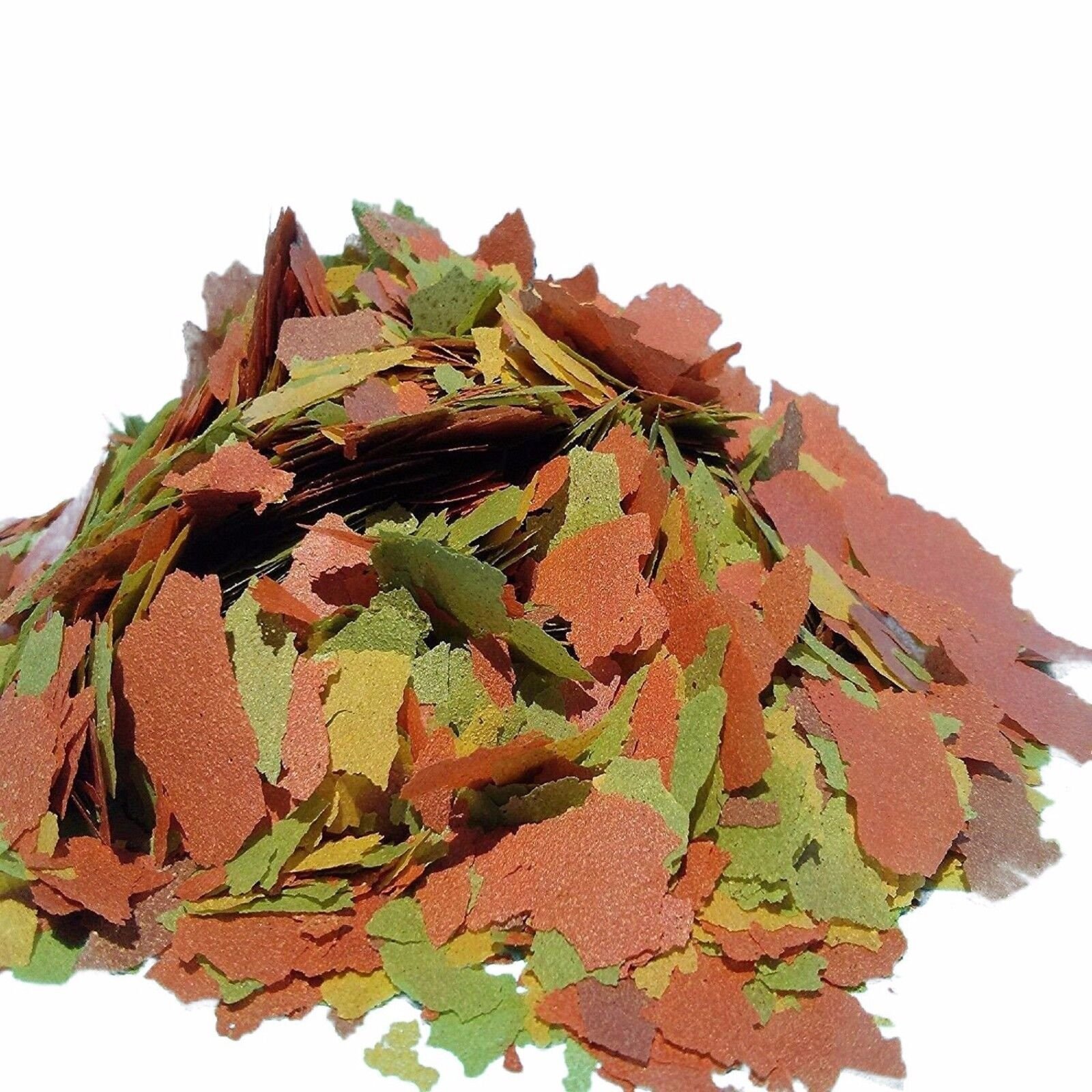
Fish Flakes
Provides a convenient way to offer a balanced and complete diet; sinking pellets are suitable for bottom-feeding fish, while floating pellets are for surface or mid-water feeders.
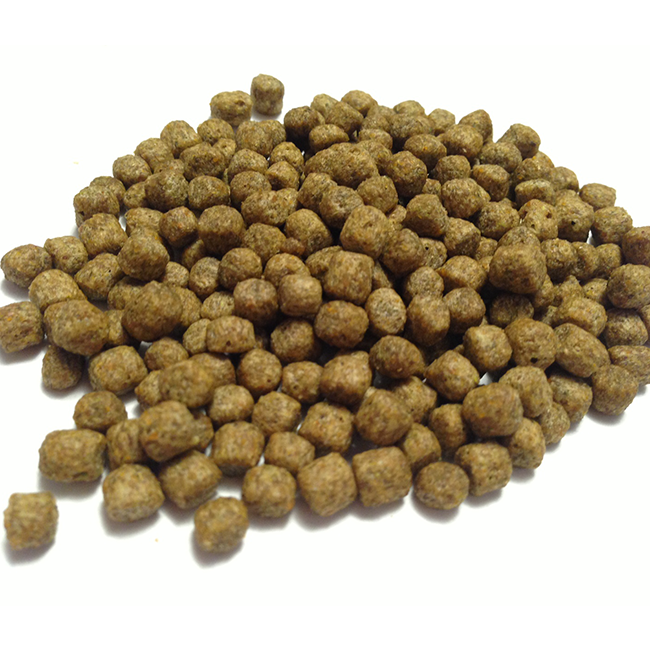
Fish Pallets
Remain suspended in the water, making them ideal for fish that feed in the middle to upper water column. Offer a visually engaging feeding experience; suitable for a variety of fish species; convenient and easy to measure.
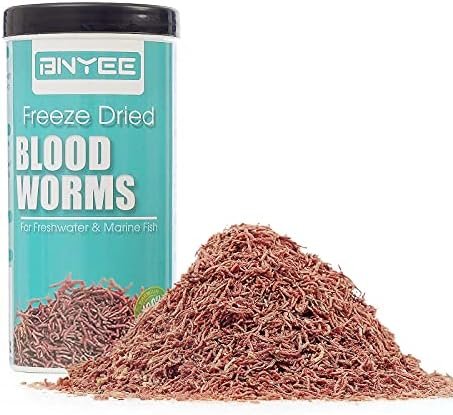
Blood Worms
Can be added as a treat or supplement; can be rehydrated before feeding. Provides a natural and protein-rich option; mimics the diet of many freshwater and marine fish; often considered a high-value treat.
Treats
Treats allow you to bond with your fish and interact with them.
But the downside to treats is that you’d need to prepare them, and they’ll be pricier than traditional fish food.

Brine Shrimp
Brine shrimp is the most popular treat out there. You'll make a batch at a time and freeze leftovers in ice cube trays for later use. Compared to other live food options (like daphnia and vinegar eels) it produces the least amount of adverse smells.
Bring shrimp is actually a completely different species of shrimp, which makes it a suitable food option.

Vegetables
Veggies are another popular snack for your goldfish. They'll be happy with virtually anything you'd feed them, like lettuce, peas, cucumbers, zucchini, carrots and spinach.
Cleaning The Tank
The second part of caring for your shrimp is cleaning your tank. Cleaning your tank is a task consisting of 3 different actions you’ll take:
Changing the water
You’ll be changing the water in your tank about every week or so.
The 2 biggest signs you need to change the water are:
- It’s been about a week since the last one (yep, it’s that easy)
- You tested the water and the test indicated a change is needed (all about that in Chapter 3)
Maintaining a fish tank is more about keeping the water parameters within range. That’s about 95% of it.
When you’re first starting out you’ll want to test your water more frequently so you can get a sense of your water conditions. Testing your water is as easy as dipping a testing strip in it and comparing the results.
While we do cover in detail how to do a water change later on in the guide, for now here’s a birds-eye overview of what’s expected:
- Remove approximately 20-30 percent of the existing water using a siphon.
- Prepare a separate container with fresh tap water and introduce water conditioner to it.
- Pour the newly conditioned water into the tank.
- Discard the old tank water.
Siphoning the Substrate
The process of removing the tank water can take a couple of minutes, so while you are at it it’s a good idea to clean the substrate.
You achieve it using a siphon pump, the same one you use when removing the water from the tank. If you have question marks popping in your head right now- don’t worry. We cover all of those in the next chapter.
Scrapping Algae
The last part of cleaning a tank involves scraping algae.
Not all tanks will grow algae on a scale that requires scrapping- it is mostly prevalent in tanks that have live plants.

Algae in a fish tank

Cons Of Keeping Shrimp
And How To Prevent Heartaches
Just like any animal, shrimp aren’t perfect.
Here are the top 3 negative aspects specific to goldfish:
Escape Artists
Some shrimp species, especially smaller ones, can be skilled at escaping from tanks with small openings. Covering the tank adequately is necessary to prevent accidental escapes.
Cannibalism
In certain situations, particularly in densely populated tanks or if there’s a shortage of hiding places, shrimp may exhibit cannibalistic behavior, especially towards molting or weak individuals.
Short Lifespan
While some shrimp species can live for several years, their lifespan is generally shorter compared to other aquarium pets. Factors like genetics, care, and environmental conditions can influence their longevity.
Preventing Heartache
There are 2 very simple ways to give your shrimp the best life:
- Design the tank correctly with plenty of hiding space where other fish won’t get to them.
- Test the water often and change it when parameters fall below desired levels.
At this point I already sound like a broken record- but we are going to cover those in the next chapters.

How Aquariums Work
So You Can Be A More Confident Fishkeeper
Fish Tank Glossary For Absolute Beginners
You might have heard some terms in the connection of a fish tank. Regardless of what you know or don’t know- this will teach you everything you need to know.

At this point, you might begin the suspect that this list isn’t every possible aquarium-related term. You are right- and it’s on purpose.
You are learning only what is relevant to you to keep shrimp. There is no point in explaining reverse osmosis water, for example, because you don’t need it (you’d need it if you had a saltwater tank, by the way)
Fish Tank Magic for Intermediates
For you to be a confident fishkeeper you’ll want to understand how your fish tank works, as this simple concept will help you troubleshoot issues and know what adjustments to make.
The foundation of your aquarium’s ecosystem is the nitrogen cycle. This natural process involves beneficial bacteria breaking down waste produced by fish poop and leftover food.
In nature, it happens naturally- mainly because beneficial bacteria are ample.
In your fish tank, it’s your filter that is responsible for introducing this bacteria.
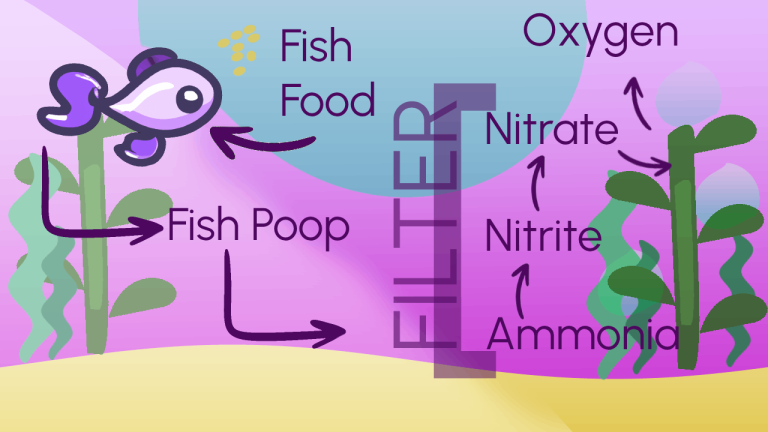
Recap
We’ve covered quite a few things here today, so let’s quickly recap:
Caring for a shrimp consists of 2 tasks: feeding and cleaning.
You’ll feed your shrimp twice a day, and clean its tank about once a week. If you are homing them with other fish, feed them all at the same time.
What turns your tank into a functioning ecosystem is your filter.
Fishkeeping is very similar to gardening. You’re main task is to keep the water within parameters.
Next, we’ll talk about setting up your fish tank. We’ll cover all the equipment you need, how to size your tank, and everything in between.
